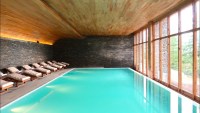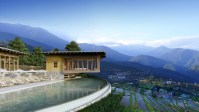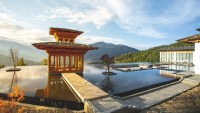The fairytale, mystical Kingdom of Bhutan is world-famous for measuring Gross National Happiness, an index which is used to measure the collective happiness and well-being of a population. Bhutan is a spectacular, unspoilt country steeped in ancient traditions and with a history that is as tall as its Himalayan mountain peaks. It’s a country where mystical Buddhism thrives, archery is the national sport, almost everyone wears national dress, and traffic lights are absent. The Kingdom is on top of many travelers’ bucket lists (and for good reason), yet is tricky to visit (more on that below).
Get the most out of your (luxury) trip to Bhutan with my travel guide. Find out more about:
- Best time to visit
- How to get there
- Travel requirements
- Getting around
- Inspiration, highlights, & travel tips
- Suggested itineraries
- Recommended luxury hotels (+ reviews)
BHUTAN TRAVEL GUIDE; BEST TIME TO VISIT
The climate in Bhutan is extremely varied, which can be attributed to two main factors: the vast differences in altitude present in the country and the influence of North Indian monsoons.
Regional differences
Southern Bhutan has a hot and humid subtropical climate that is fairly unchanging throughout the year. Temperatures can vary between 15-30 degrees C° (59- 86 degrees F°). In the central parts of the country – which consists of temperate and deciduous forests – the climate is more seasonal with warm summers and cool and dry winters. In the far northern reaches of the Kingdom, the weather is much colder: mountain peaks are perpetually covered in snow and lower parts are still cool in summer owing to the high altitude terrain.
Seasonal differences
Apart from the regional differences, Bhutan has four distinct seasons in a year:
- Bhutan’s generally dry spring starts in early March and lasts until mid-April. Summer weather commences in mid-April with occasional showers and continues to late June.
- The monsoon begins from late-June through July to late-September and brings between 60 and 90 percent of the country’s rainfall. Annual precipitation ranges widely in various parts of the country, with most of the precipitation falling in the humid, subtropical southern part of the country.
- Autumn, from late September or early October to late November, follows the rainy season. It is characterized by bright, sunny days and some early snowfall at higher elevations.
- From late November until March, winter sets in, with frost throughout much of the country and snowfall common. The winter northeast monsoon brings gale-force winds at the highest altitudes through high mountain passes, giving Bhutan its name – Drukyul, which means Land of the Thunder Dragon in Dzongkha (the native language).
The best season to visit Bhutan is autumn, because of the dry weather and crispy clear days. Spring is also a good season, although there is more chance of overcast days. For a month-to-month overview of the weather in Bhutan, check this website.
BHUTAN TRAVEL GUIDE: HOW TO GET THERE
The only international airport in Bhutan is located at Paro, about a one hour drive from Bhutan’s capital city Thimphu. Currently, there are only two Bhutanese airlines allowed to operate flights to and from Bhutan – Drukair and Bhutan Airlines – and tickets can be booked online. Departure points include Bangkok (Thailand), Kathmandu (Nepal), New Delhi and Kolkata (India), Dhaka (Bangladesh), Yangoon (Myanmar), and Singapore. Weather can delay flights for days at a time, so it’s important to have your itinerary designed with a few days in your stopover city and (if possible) to fly on an unrestricted ticket.
It’s also possible to travel to Bhutan from India overland by road. The main border crossing is Jaigon-Phuentsholing. There are two others, at Gelephu and Samdrup Jongkhar.
Before you buy a plane ticket, consider reading my tips & tricks for buying the cheapest plane ticket.
BHUTAN TRAVEL GUIDE: TRAVEL REQUIREMENTS
To protect its natural resources and authentic culture, and to ensure that travelers don’t overwhelm the country, the Bhutanese government controls (and restricts) the number of visitors into the country. Only travelers on packages booked through tour operators are allowed visas, so independent tourists and backpackers can’t get in, plus there’s the infamously expensive tourist tax (minimum daily tariff), which puts off a lot of potential visitors.
Passport & visa
- Everyone traveling to Bhutan must obtain a visa in advance, except for passport holders from India, Bangladesh and the Maldives. The visas must be applied and paid for in advance ($40 USD per person) and are only issued to tourists booked with a local licensed tour operator, either directly or through a foreign travel agent. You should try and make your travel arrangements at least 90 days prior to travel to allow time for all the formalities to be completed.
- Your international passport should be valid for a minimum period of 6 months after the date you intend to leave Bhutan.
Tourist tax
International visitors to Bhutan now have to pay a “sustainable development fee” of $200 USD a night, up from $65 per night prior to the pandemic, to gain entry. This will be on top of the costs of accommodation, guides and other services – significantly raising the price of a visit. This increase in traveler fee will support development projects within the kingdom, including towards free education and healthcare. Some of the funds will also go towards planting trees, helping tourism industry workers to gain more skills, maintaining Bhutan’s trails and more.
In almost all cases, your tour or hotel operator (e.g. Six Senses, Aman, etc …) will take care of all the administration (visa & tourist tax), so in the end, it’s a very simple and straightforward process.
Make sure you read my 10 tips to plan a worry-free trip.
BHUTAN TRAVEL GUIDE: GETTING AROUND
In Bhutan it’s only possible to travel by private car and driver (the cost of all transport is included in the minimal daily tariff). Most tourists travel in a 4 wheel drive (or minibus) with a driver and English speaking guide, arranged via their tour or hotel operator. There is only one main road – the National Highway – which crosses the country and winds twists and turns from west to east along the main cities. The roads are pretty well maintained and go via mountain passes with sweeping views and prayer flags fluttering in the wind to remote villages with cobbled streets and traditional houses.
It’s also possible to make us of limited domestic air service, which is restricted to Paro, Bumthang and Gelephu. Bhutan’s only domestic carriers are Drukair and Bhutan Airlines.
BHUTAN TRAVEL GUIDE: INSPIRATION, HIGHLIGHTS, & TRAVEL TIPS
There are several reasons why you should put Bhutan on your bucket list:
- Hike the sacred path to Tiger’s Nest, Bhutan’s most iconic temple
- Visit the ancient fortress of Punakha Dzong
- Explore the outdoors (hiking, white water rafting, cycling, etc …)
- Explore Thimphu, the world’s only capital without traffic lights
- Observe wildlife, including the rare black necked cranes
- Drive along majestic mountain passes
- Attend a colorful Bhutanese festival
The following, comprehensive articles may also inspire you and help you plan a holiday to Bhutan:
- Top 10 must see sights in Bhutan
- Top 10 best hotels & lodges in Bhutan
- Tips & tricks for getting the best deal at a luxury hotel
- Tips & tricks for buying the cheapest plane ticket
BHUTAN TRAVEL GUIDE: SUGGESTED ITINERARIES
Bhutan is a relatively small country, so it’s possible to see a lot of the country in a short time span. I hereby share with you a one week itinerary:
- Day 1 & 2: explore the capital Thimphu & surroundings
- Day 3, 4 & 5: drive via Dochula Pass to Punakha (3 hours) & explore Punakha Valley (outdoor activities, visit to the Dzong, etc …)
- Day 6 & 7: backtrack to Paro via Thimpu (4 hours) & explore Paro Valley (including full day tour to Tiger’s Nest)
If you have more time (2 weeks), I suggest to explore the farthest reaches of Bhutan’s inhabited regions and add Gangtey & Bumthang to jour itinerary.
I highly recommend to book your stay in Bhutan with either Six Senses or Aman. Both companies operate multiple lodges in Bhutan and have detailed itineraries on their website, which give you a excellent idea of what to expect from day to day:
- Click here to explore 4, 5, 6, 8 and 10 nights Bhutan itineraries offered by Six Senses
- Click here to explore 3, 4, 7, 8, 9, 11 and 12 nights Bhutan itineraries offered by Aman
RECOMMENDED LUXURY HOTELS (+ REVIEWS)
I recommend to visit my top 10 list of the most fabulous hotels in Bhutan if you are eager to know how I rank Bhutan’s top hotels, based my own experience.
Below, you find my reviews of hotels in Bhutan (with pros, cons, & tips to save money per hotel).
 Review of Six Senses Bhutan, Paro Lodge
Review of Six Senses Bhutan, Paro Lodge Review of Six Senses Bhutan, Punakha Lodge
Review of Six Senses Bhutan, Punakha Lodge Review of Six Senses Bhutan, Thimphu Lodge
Review of Six Senses Bhutan, Thimphu Lodge
*** Follow me on Twitter, Instagram and Facebook for a daily moment of travel inspiration ***


I continue to enjoy your newsletters and reviews enormously. But I just want to point out that your review of Bhutan is a bit out of date. Since September the Government has changed the regulations around visiting the country. Rather than explain it all to you here it would be easier for you to research it yourself. Those in the tourist industry in Bhutan are deeply unhappy about the changes as it means that many tour companies are going out of business and hundred of people have lost their jobs. I’m one of the lucky ones who has an open invitation to go whenever I want. Next year I will return to celebrate 50 years since my first visit. Tashi Delek.
My sincere apologies. I read your review too quickly and see that you are up to date. I’m so sorry!